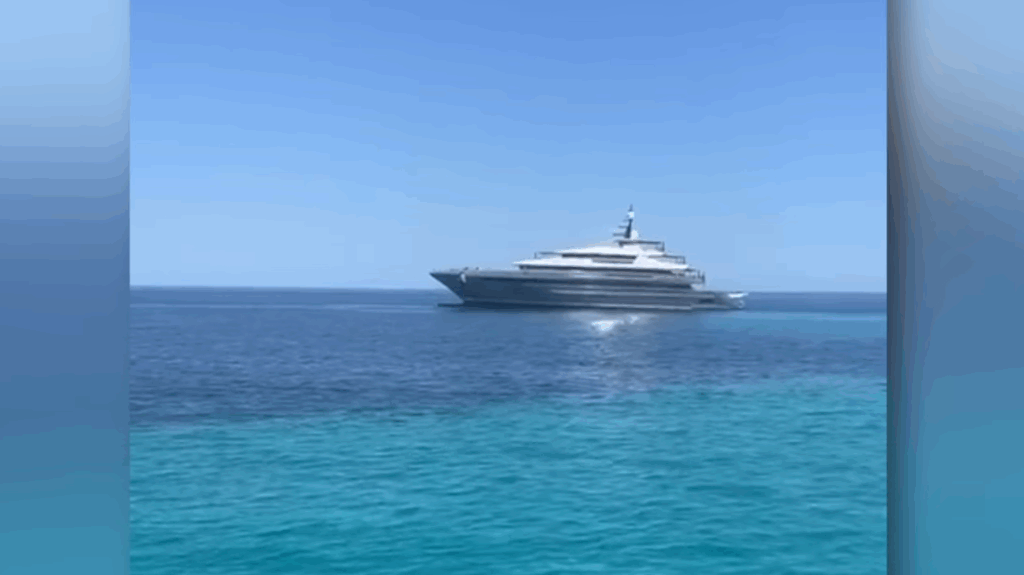Video: Superyacht Attila runs aground off Formentera
 Attila runs aground off Formentera. Image courtesy of @exponiendoibiza on Instagram.
Attila runs aground off Formentera. Image courtesy of @exponiendoibiza on Instagram.
The 64.3-metre Sanlorenzo superyacht Attila ran aground on the afternoon of 1 July 2025 off the coast of Es Pujols, Formentera.
Eyewitnesses reported the yacht, a 64 Steel with an estimated value of $70m, had entered a shallow area known as Sa Roqueta, just off Ses Canyes beach on the island’s eastern coastline, shortly after 2.00pm before becoming beached. The grounding quickly attracted attention from both local residents and tourists, and images of the incident circulated widely on social media.
Attila is the largest vessel ever built by Italian yard Sanlorenzo and was delivered in 2019 as its flagship. The five-deck vessel features a helipad, swimming pool, spa, and accommodation for 12 guests and 18 crew members. On-board amenities include a climate-controlled wine cellar, a large barbecue in the main deck dining area and a 78-square-metre beach club with a sauna, Hammam, massage room and gym.
The yacht’s exterior design is by Officina Italiana Design, with interiors by Francesco Paszkowski and Margherita Casprini. The yacht can reach 17 knots and has a range of up to 6,000 nautical miles.
Despite initial concerns, authorities confirmed that the incident did not result in pollution or damage to the area’s posidonia seagrass meadows, which are protected and ecologically significant in the region.
Nonetheless, the Maritime Authority of Eivissa and Formentera, under the general directorate of the Merchant Marine, ordered the provisional detention of the yacht, citing “dangerous navigation near the coast.” The authority also required a refloating plan and an underwater hull inspection before the yacht could be safely moved.
However, according to Vesseltracker, “the shipowner ignored these instructions and removed the ship without the required safety measures, such as the approval of the International Insurance Company or the performance of an underwater inspection to check if the hull was damaged.” The site reports that a penalty will be imposed for failing to comply with official orders.
Salvamar Naos, a maritime search and rescue vessel, was deployed on 2 July to assist in the refloating process. The yacht eventually freed itself around 11am using its own auxiliary boats and minor towing manoeuvres, aided by a rising tide.
Following the incident, Attila proceeded to Marina Ibiza under the instruction of the harbourmaster. There, the yacht is scheduled to undergo an MOU inspection, a standard safety review for foreign-flagged vessels conducted by Maritime Authority officials.
The event has reignited discussions about the growing pressures luxury maritime tourism places on Formentera’s fragile marine ecosystem, particularly during the high summer season. As Forbes España noted, “The incident has reopened the debate on the pressure that luxury nautical tourism exerts on the fragile marine environment of the Pitiusas, especially in the middle of the high season.”
A report from local outlet 4Mentera also drew attention to broader concerns in the region, stating: “These types of incidents, increasingly common, highlight the need for caution, adherence to maritime regulations, and the technical competence of crews navigating these waters.”
4Mentera reports that, on the same day, a separate incident involving a German-flagged motorboat near s’Espalmador added to local anxieties, when smoke began pouring from its engine room, prompting a swift response from nearby boats and maritime rescue services.
So far, no injuries or pollution have been reported as a result of Attila’s grounding, though the long-term impact and any damage to the vessel’s hull remain under review.












It’s a pity they didn’t have the Watchit system that could have easily prevented such occurrence – see https://marineindustrynews.co.uk/?s=watchit&x=0&y=0
The answer is Watchit
https://watchit.ai/
this is the only system that stops this happening
Just like most other large superyachts, this yacht should consider installing the WASSP Multibeam Ssonar on their tender(s) to remotely make their own detailed 2D and 3D maps of the underwater seafloor in the areas the yacht wants to enter.
If the area is poorly charted or not mapped at all, this is the only way.